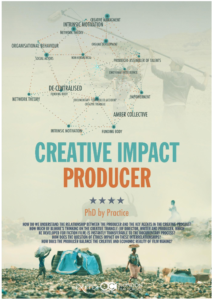 Anna Sowa is a documentary film producer with a strong background in international affairs policy and academic research. After completing her BA in Arabic with International Relations, Anna continued her professional and academic interest in international development at SOAS, University of London where she graduated with a distinction MSc in Migration, Mobility and Development. She is the co-founder of Chouette Films– an award-winning production company committed to using film as a tool for social change. She is a PhD by practice candidate at the London Film School/ University of Exeter researching the role of the producer in collaborative documentary filmmaking.
Anna Sowa is a documentary film producer with a strong background in international affairs policy and academic research. After completing her BA in Arabic with International Relations, Anna continued her professional and academic interest in international development at SOAS, University of London where she graduated with a distinction MSc in Migration, Mobility and Development. She is the co-founder of Chouette Films– an award-winning production company committed to using film as a tool for social change. She is a PhD by practice candidate at the London Film School/ University of Exeter researching the role of the producer in collaborative documentary filmmaking.
A piece of advice that I remember from my school drama teacher years ago, is to always practice and test your acting by performing in front of a young child. If the child stays focused and interested, even without necessarily understanding the piece, then you have successfully achieved a genuinely engaging performance. At the same time, this teacher also used to encourage us to be authentic and to stay genuine to ourselves. I now understand how these two pieces of advice are interlinked. The teacher wanted us to find our own way of expressing each piece, to create a performance which both felt natural and was uniquely captivating. Rather than exaggerated or over-dramatic acting, simply for the sake of being shocking or different, innovative and heart-felt acting is the key to engaging an audience.
Although drama lessons may sit on a very different branch of the arts to academic posters, I still find my old teacher’s advice very meaningful to the process of design.

Firstly, testing your work is of pivotal value to poster design. It may seem like a peculiar choice to start with this focus on testing, because it is often under-estimated as a minor and latter part of the design process. However, from my experience it is crucial to continually test an idea from its conception through to its completion as a final product. Share your ideas with someone who works in your field; share them with a stranger; share them with a child. The more diverse the group, the more well-rounded the feedback. Show them your sketches and scribbles to see what catches their interests. Testing ideas gives you the tools to analyse, reshape and build on your design.
Secondly, authenticity is vital to the meaning and impact of a poster. So, make it personal; make it yours. My work investigates the very role that I play: that of the producer. Since the perspective of my study is self-reflective and my PhD is practice-based, it felt natural for the poster to depict myself in action at a film shoot. From afar, the poster’s graphics resemble a regular film poster. Visually, this creates an instant association of the poster with film, no matter how unfamiliar the viewer may be with the subject matter of my research. It is important to make sure that your individual vision for the project remains integral to your design. Pinpoint the key images that represent your work, and experiment with ways of building graphically around these concepts.
Thirdly, I believe that the golden rule of poster design is “less is more”. The busier the poster, the less comprehensive and compelling. Too many sentences can cloud its meaning. Instead, use headlines and bullet points and let the images speak for themselves. Clear and aesthetically simple designs can be the most powerful. Pick out the key words from your research and strip back any unnecessary jargon, so that your poster communicates to every viewer, even a child.
After all, the simple truth behind academic poster design is that art can support science. Far from being its antagonist, art can enhance the clarity of conceptual scientific descriptions.
Written by: Anna Sowa- Film PhD by Practice Researcher
Chouette films website
Twitter: @ChouetteFilms
Interested in this year’s competition is open until Friday 20 April, full details about Postgradaute Research Showcase, the poster competition and our other competitions, 3 Minute Thesis and Tweet your Thesis can be found here.
